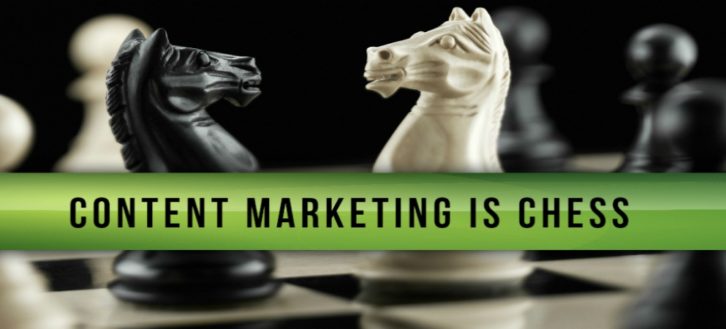Too many businesses waste money on content marketing that’s ineffective and wasteful.
How many companies have blogs that have long been abandoned?
How many companies treat writing content like a chore, a box that just needs checked every week, rather than a valuable business tool?

How many companies gave up because content marketing simply didn’t seem to work at all?
According to a study by Content Marketing Institute, 93 percent of B2B marketers say they use content marketing.
But, the same study found that only 42 percent, less than half, say they are effective at content marketing.
And only 41 percent of larger organizations said they even have a documented content marketing plan.
That’s a big problem.
And it points to one of the fundamental problems with the way companies understand and execute content marketing.
As effective as it can be too many companies treat content like a magical fix or a necessarily evil. In reality, it’s neither of those things.
Too many companies fall into the trap of thinking that they can grow their business by simply having a blog and posting something, anything, once a week. It’s just a repetitive task that’s to be done regularly and infinitely, forever and ever until something happens. Right? Wrong.
These companies are treating content marketing like checkers.
In checkers, all pieces are equal and you only have a few moves to make. You move forward and capture a piece when you have a chance. You can think ahead a few moves, but there’s very little actual strategy. It’s mostly about reacting to what your opponent does.
But they’ve got it all wrong. Content marketing isn’t checkers. It’s chess.
Content Marketing as Chess

In chess, each piece has a specific role. Their limitations are their strengths. And to win, you need to use each of them in concert, with precision and planning, to execute a strategy and outsmart your opponent. You need to plan in advance and see several moves ahead.
Many people know the basic mechanics of chess, but few people are truly masters of the game. That’s exactly how content marketing works.
In order to be effective at content marketing, it takes more than just writing and publishing content. Any schmuck can hire some kid to write blog posts once a week for $20. But if you’re expecting that to grow your business, then you’re playing checkers and your competitors (at least the ones that are good at content marketing) are playing chess.
Great content marketing involves a lot of nuanced and creative planning. It takes strategy and tactics. It takes investment.
Each piece of content has a role to play, a unique set of capabilities. It’s our job, as marketers, to move the pieces and put them in just the right position to win the game.
That means creating unique pieces of content that speak to various buyers and stakeholders. It means creating content that serves strategic purpose within the buyer’s journey, from search to social to purchase and beyond.
It means creating a mix of guides, how-tos, videos, and case studies. And then all of the content needs to be moved at just the right time. Relevant content needs to be served up to a prospective buyer at the time when it makes sense to them. That takes technology and planning.
Looking Beyond Content
Content for the sake of content marketing takes a lot of planning and strategy. But let’s not forget that content marketing is almost always the basis for a much more-robust digital marketing strategy.

Content drives SEO and social strategies, which in turn have their own caveats. In order to be successful at SEO, you need to have strategies that generate links, domain authority, and social signals. All of these require their own consideration within your content marketing strategy that goes beyond just the role that it plays in the buyer’s journey.
If we take a macro view, Copyblogger says there are four main types of content:
- Attraction
- Authority
- Affinity
- Action
But that only tells part of the story. You also have to overlay your digital marketing goals:
- Link building
- Search/keyword relevance
- Social virality
All told, you have a huge number of types of content that can be created.
Each piece of content needs to serve a role within our content marketing and marketing strategies. But, most piece of content won’t be able to serve all of these goals. We need to identify the needs within our strategy and then come up with specific content that can meet those needs.
It’s not as simple as just writing blog posts.
Invest or Lose

As a business, it can be hard to justify investing thousands of dollars in your “blog” each month. Especially when you can hire someone to crank out content for a couple of bucks an article.
But that’s a short-sighted approach. It’s looking at content as checkers instead of chess.
What you gain in savings on content, you ultimately lose by spending money on ineffective content that becomes a cost rather than an investment.
Think of it this way: Would you rather spend $1,000 on content without purpose or invest $10,000 in a proper content strategy and generate $20,000 in revenue?
Planning to Fail to become a grandmaster: The Benefit of Premortems for Your Marketing Strategy

Failure. It’s what we most seek to avoid, but sometimes it’s inevitable.
Learning from failure is a quality of highly successful people.
Better yet, effective marketers and positive thinkers plan ahead for failure.
Establishing a premortem for next year marketing projects puts you ahead of your potential failures.
If you anticipate the worst, you are automatically prepared for the best. Poking holes in your own strategies strengthens them to withstand possible mistakes.
The premortem process takes time and effort, but in the long run, any company is better for using this exercise. Working through what is also called prospective hindsight early in the year gives your team the best outline for how to achieve goals – big and small. It’s time to learn about how to discover premortems, implement them into your strategy and build your success.
4 Step Treatment Before the Marketing Autopsy

When a patient receives a fatal diagnosis, doctors prescribe treatment to heal the problem rather than waiting for an autopsy to see what caused the death. A marketing strategy should be the same; predicting risks beforehand sets up a team to avoid them or treat them when they arise.
Begin your premortem exercise by bringing together your team in one room shortly after presenting a plan.
Then, ask everyone to write down every idea of potential causes of failure. Encourage team members to think outside the typical realm of marketing strategy.
Go beyond things like budget, reach and company-controlled aspects. Things such as public perception, a volatile market or even government regulations can have an unexpected but great affect on marketing.
Once all of these “outside-of-the-box” ideas have been presented, the project manager can assess input. Sometimes, team members bring an idea to the table that no one else had considered, such as time constraints or the practicality of a plan. Addressing these factors before your plan is actually put into motion can ensure that it is optimized to generate the best outcomes possible.
Fresh Perspective

If gaining ideas about probable failure is proving difficult for a marketing team, bring in a fresh perspective.Mining the thoughts of company executives, sales people, and even finance or IT professionals can produce ideas from brains not focused on the ROI of marketing automation or how many Twitter followers the company has.
These new voices bring value to both the business and your premortem exercise. Their knowledge about different areas of the organization, particularly their different relationships with customers, is a good place to gain new opinions and concepts of failure. A misstep in the mind of a sales person might inspire a marketing opportunity.
A deficiency in the budget might be glaringly obvious to the finance team, but not to the marketers. No team is alone in what it does, so it’s wise to draw upon the resources of diverse individuals and groups with different concerns.
Using Your Mistakes

Now that you’ve established your premortems, you can apply them to your plan for success. When military forces are devising a strategy for a mission, they outline backup plans for every possible mistake. Putting these alternate plays in the playbook allows soldiers to react quickly with a well of information to keep them safe.
Marketing is not usually a life or death situation, but the same principles apply. The premortems act as a backbone of laying out substitute plans. In a sense, they are the points in a navigation system that recalculate your route to the destination of accomplishment if you take a wrong turn.
If one campaign goes over budget, you’ll have to cut back on another one. If customer reception of a certain material is negative or aggressive, you can rebound with a reframing of the language. If the data that drives a certain strategy was wrong or didn’t deliver, you can salvage the strategy with your own knowledge about customers and their needs.
You can’t anticipate everything that might go wrong, but attempting to do so gives you the advantage of knowing how to deal with failure – and even the unexpected.
Wisdom and Enlightenment

The philosopher and poet Lao Tzu said, “Knowing others is wisdom. Knowing yourself is enlightenment”, and knowing both is the strongest defense against making mistakes.
These ideals are true to both life and marketing, and applying them to premortems provides a comprehensive view of what could go wrong this year and how to prevent, mitigate or remedy it.
In 1989. researchers found that prospective hindsight increases the ability to correctly identify reasons for future outcomes by 30 percent. Psychologists have also seen that decision making is positively influenced by looking back at the future.
So premortem philosophy not only works when developing a marketing strategy, but also slowly infiltrates your thinking and the way you make choices. Are you ready to forecast failure to harness the potential of working smarter toward your goals?
Checkmate.

Fletcher Kennith is professional writer from Essay4Students and experienced blogger with over 5 years of writing about marketing, business development and sales management. Also he has success in the areas of Data entry and project management.


